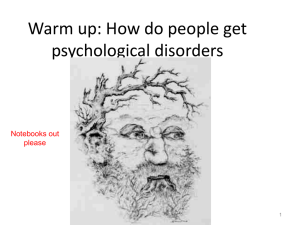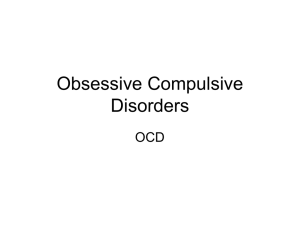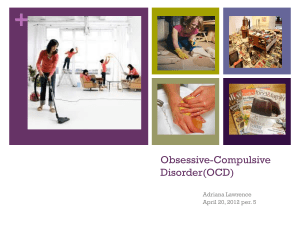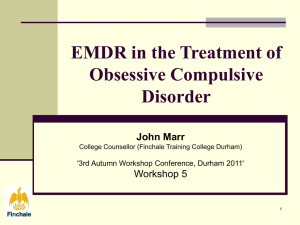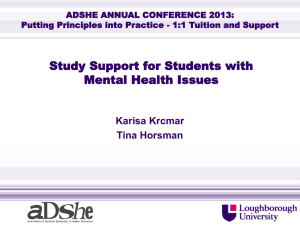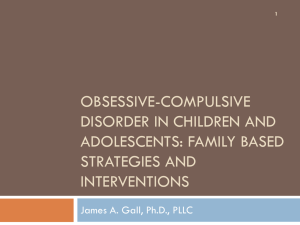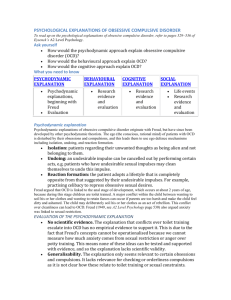PowerPoint Presentation - The Onset & Course of OCD
advertisement
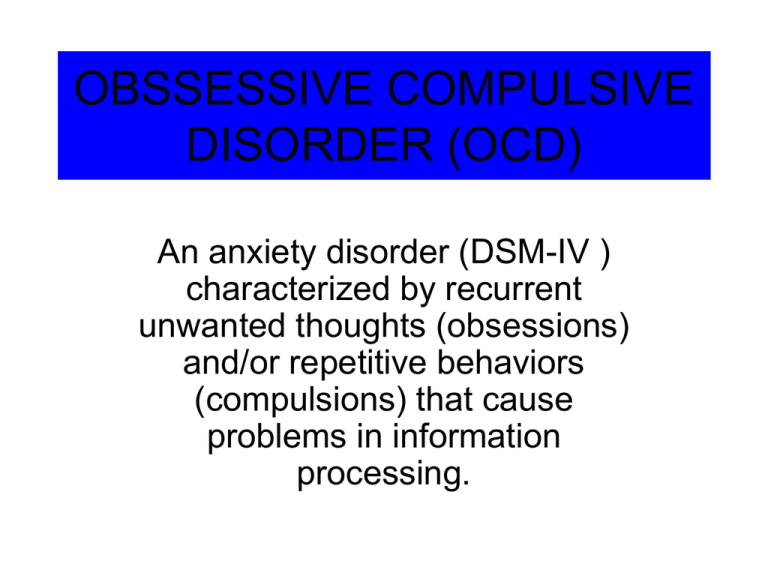
OBSSESSIVE COMPULSIVE DISORDER (OCD) An anxiety disorder (DSM-IV ) characterized by recurrent unwanted thoughts (obsessions) and/or repetitive behaviors (compulsions) that cause problems in information processing. PREVALENCE • About 3.3 million American adults ages 1854 have OCD. (National Institute of Mental Health) www.nimh.nih.gov. • Equally common in both males & females. GENERAL REQUIREMENTS • The person must have recognized at some point that the obsessions or compulsions are excessive or unreasonable. • These recurrent obsessions or compulsions must be severe enough to be time consuming (taking up more than 1 hour per day). • The obsessions/compulsions must cause a marked distress or significantly interfere with the individuals normal routine, occupational functioning, or usual social activities or relationships with others. COMMON OBSESSIONS (Thoughts) • Repeated thoughts about contamination (public restrooms or shaking hands). • Repeated doubts (leaving lights on or leaving the door unlocked) • Things or objects need to be in a particular place or order (intense distress when objects are disordered or asymmetrical) COMMON COMPULSIONS (Behaviors) • Hand washing (so repetitive that they become raw). • Counting (how many cards in a deck, over and over again). • Cleaning (spots on windows) • Checking (the lights to make sure they’re off; locked doors every few minutes. • Request/demand assurances • Repeat actions & ordering. CHILDREN: (associated with) • Learning Disorders • Disruptive Behavior Disorders ADULTS: (associated with) • • • • • • • Major Depressive Disorder Specific Phobia Social Phobia Panic Disorder Generalized Anxiety Disorder Eating Disorders (Anorexia/Bulimia Nervosa) Personality Disorders: (Obsessive Compulsive Personality Disorder, Avoidant Personality Disorder, Dependent Personality Disorder) FEATURES • • • • • • • • • Age Range: Males (6-15 years) Females (20-29 years). Equal occurrence in both genders. Obsession with dirt/germs: Avoid using public restrooms. Hypochondriacal concerns: make repeated visits to the doctor for reassurance. Obsession with guilt: have a pathological sense of responsibility. (Depressed because they don’t want to feel this way but can’t stop because of guilty feelings). Excessive use of alcohol or sedatives, hypnotic or anxiolytic medications (Xanax, Valium, Librium, Rivotril, Ativan). Avoidance of situations; keep to themselves mostly; stay at home (so others don’t see odd behaviors). Those with mild cases may be quite successful in life because they are overly conscientious and are perfectionists. Obsessions may not be as obvious as compulsions. OCD DSM-IV CRITERIA OBSESSIONS • Recurrent & persistent thought, impulses, or images that are experienced, at some time during the disturbance, as intrusive and inappropriate & that cause marked anxiety or distress. • The thoughts, impulses, or images aren’t simply excessive worries about life problems. • The person attempts to ignore or suppress such thoughts, impulses, or images, or to neutralize them with some other thought or action. • The person recognizes that the obsessional thoughts, impulses, or images are a product of his/her own mind (not imposed from without as in thought insertion). COMPULSIONS • Repetitive behaviors (e.g., hand washing, ordering, checking) or mental acts (e.g., praying, counting, repeating words silently) that the person feels driven to perform in response to an obsession, or according to rules that must be applied rigidly. • The behaviors or mental acts are aimed at preventing or reducing distress or preventing some dreaded event or situation; however, these behaviors or mental acts either are not connected in a realistic way with what they are designed to neutralize or prevent or are clearly excessive. The Onset of OCD • Usually begins in adolescence or early adulthood • Occasionally in childhood • Obsessions or cleaning rituals only vs. checking or mixed rituals • Males vs. Females • Onset is usually gradual. Some acute cases have been diagnosed Course of OCD • May experience a waxing and waning course • About 5% have an episode course with minimal or no symptoms between episodes. • Progressive deterioration in occupational and social functioning • 90% of patients can expect to have moderate to marked improvement with optimum treatment. Causes of OCD • Parental influence and family rituals • Not learned • Causes now focus on neurobiological factors and environmental influences Causes of OCD • Elevated activity in the Frontal Lobe and Basal Ganglia • Activity is not typical in people without mental illness • PET (Positron emission Tomography) scan used in brain imaging Brain Activity Assessment Techniques • Office Visits • The Anxiety Disorder Interview Schedule – Revised (ADIS-R) • The Yale-Brown Obsessive-Compulsive Symptom Checklist (Y-BOC) • The Leyton Obsessional Inventory (Lol) • The State Trait Anxiety Inventory of Children (STAIC) Differential Diagnosis • Anxiety disorder Due to a General Medical Condition • Substance induced Anxiety Disorder • Body Dysmorphic Disorder • Specific or Social Phobias (Trichotillomania) • Major Depressive Episode • Generalized Anxiety Disorder • Hypochondriasis • Specific Phobia • Delusional Disorder • Psychotic Disorder Not Otherwise Specified Differential Diagnosis Con’t. • • • • Schizophrenia Tic Disorder Stereotypic Movement Disorder Eating Disorders, Paraphilias, Pathological Gambling, Alcohol Dependence or Abuse • Obsessive Compulsive Personality Disorder • Superstitions and Repetitive Checking Behaviors OCD Treatment Strategies • About 1 in 50 Americans (about 5 million people) have or will develop Obsessive Compulsive Disorder at some point on their lives OCD Treatment Strategies • Today, the ObsessiveCompulsive Foundation says that the average OCD individual spends more than 9 years searching for help, and is diagnosed by 3 to 4 doctors before finally getting the right diagnosis. OCD Treatment Strategies • Many ODC sufferers didn’t have access to information about their disorder and were too ashamed or embarrassed to seek medical help OCD Treatment Strategies • • • • People with OCD usually have considerable insight into their own problems. Most of the time, they know their obsessive thoughts are senseless or exaggerated, and that their compulsive behaviors are not really necessary However, this knowledge is not sufficient to enable them to stop obsessing or carrying out their rituals Education is one of the most powerful weapons needed to win the battle over OCD OCD Treatment Strategies Types of Treatment Pharmacotherapy Serotonin Reuptake Inhibitors Clomipramine (Anafranil) Fluoxetine (Prozac) Sertraline (Zoloft) Fluvoxamine (Luvox) Paroxatine (Paxil) OCD Treatment Strategies • Behavior Therapy • • • • • Traditional therapy which helps the client gain insight to his or her problem is not recommended for OCD A specific behavior therapy approach called “exposure and response prevention” is effective In this approach, the patient is deliberately and voluntarily exposed to the feared object or idea, either directly or by imagination, and then is discouraged or prevented from carrying out the usual compulsive response When treatment works well, the patient gradually experiences lass anxiety form the obsessive thoughts and becomes able to do without the compulsive actions for extended periods of time A therapist will usually refer an OCD client to a specialist in this kind of therapy It Comes Down to Numbers • The dual cornerstones of effective treatment for OCD are a combination of therapy and medication • 90% of patients who underwent behavior therapy had at least a 30% reduction in obsessions and compulsions OCD Treatment Strategies • Long term results from 16 studies showed that, at a mean follow-up of 29 months, 76% of patients were “very much” or “much” improved • Patients who are unwilling to participate in behavior therapy do benefit from only pharmacotherapy treatment, but symptoms reoccur when the medication is stopped. • The effective component of both types of therapy is exposure and ritual prevention OCD Prognosis • Studies have shown that OCD patients who participate in both types of therapy will be able to function well in both their work and social lives if the following factors are included: • The patient must be highly motivated • The patient’s family must be cooperative • The patient must be faithful in fulfilling “homework assignments” What Can the Family Do? • • • • • OCD affects not only the sufferer, but the whole family Family and friends often have a hard time accepting the fact that the person with OCD cannot stop the distressing behavior Family members may show anger or resentment, resulting in an increase in the OCD behavior Other times, to keep the peace, they may assist or enable the rituals Education about OCD is as important for the family as it is for the patient *Commit to family therapy *Self-help books *Join support groups OCD Prognosis • • • OCD tends to last for years, even decades. The symptoms may become less severe from time to time, and there may be long intervals where symptoms are mild For most, the symptoms are chronic With a combination of pharmacotherapy and behavior therapy, symptoms can be controlled
